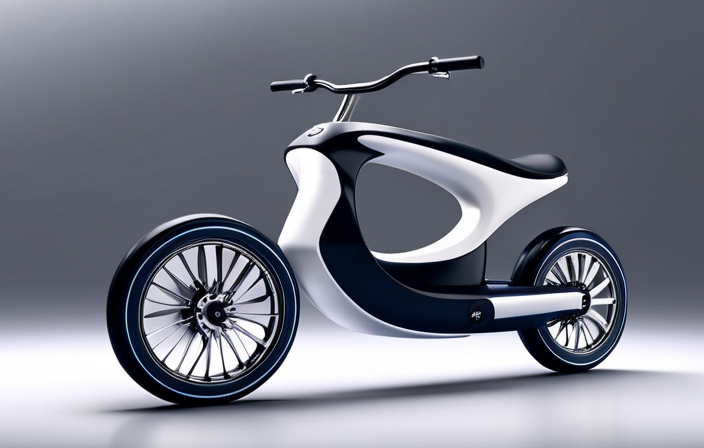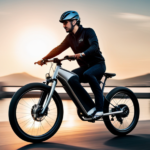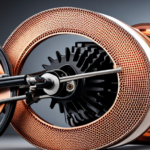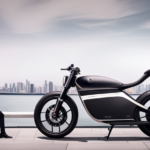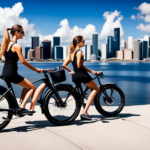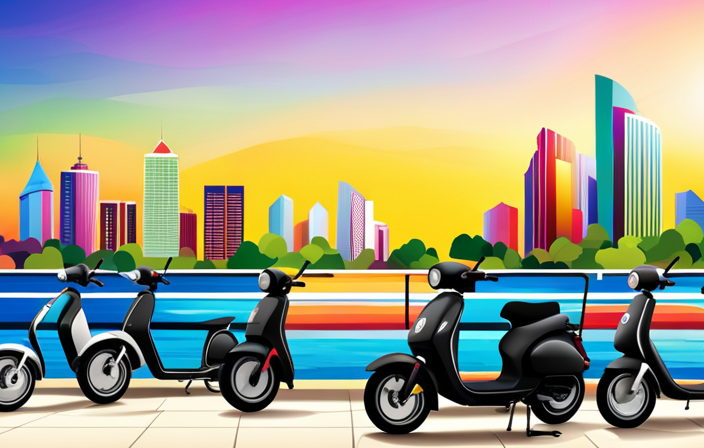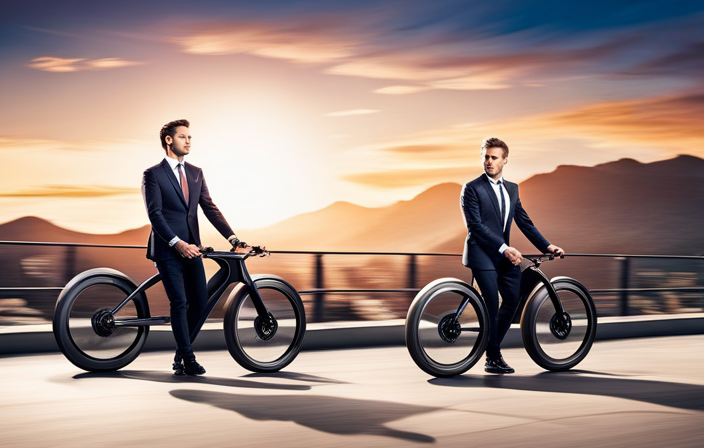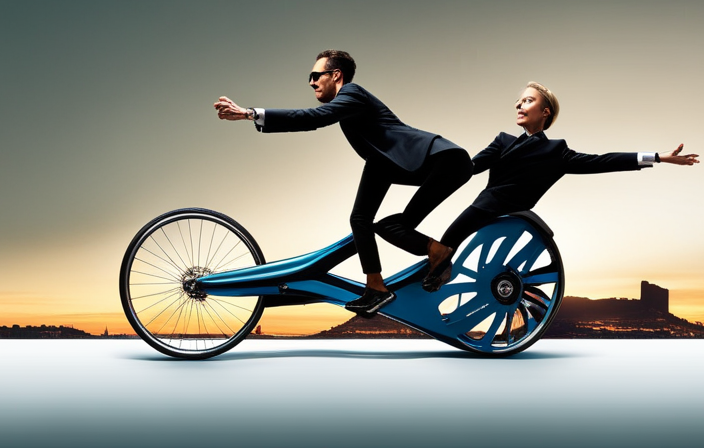Did you know that a 2000 watt electric bike can reach speeds of up to 40 miles per hour?
If you’re curious about the capabilities of these powerful electric bikes, you’ve come to the right place. In this article, we will explore the factors that determine the top speed of a 2000 watt electric bike and provide you with valuable insights on how to maximize its performance.
So, fasten your seatbelt and get ready for an electrifying ride!
Key Takeaways
- The power output of an electric bike, measured in watts, greatly affects its speed.
- Terrain conditions, such as uphill or rough terrain, can decrease the speed performance of a 2000 watt electric bike.
- Rider weight can impact the speed performance of a 2000 watt electric bike, with heavier riders experiencing slightly reduced speeds.
- Overclocking and customizing the speed settings of a 2000 watt electric bike can personalize its performance, but it comes with risks and should be done after thorough research and understanding of the implications.
Understanding Electric Bikes and Power Ratings
Understanding electric bikes and their power ratings is crucial when determining how fast a 2000 watt electric bike can go. When it comes to electric bikes, the power rating is directly related to the speed it can achieve.
Electric bikes are equipped with different motor types, such as hub motors or mid-drive motors, which affect their performance. Hub motors, located in the front or rear wheel, provide easier maintenance and are generally more affordable. On the other hand, mid-drive motors, located near the pedals, offer better weight distribution and a more natural riding experience.
Additionally, the battery lifespan plays a significant role in determining the speed of a 2000 watt electric bike. A higher quality battery will provide more power and a longer range.
Exploring the features of a 2000 watt electric bike will give you a better understanding of its capabilities.
Exploring the Features of a 2000 Watt Electric Bike
Exploring the features of a 2000 watt e-bike reveals a multitude of impressive characteristics. This high-powered electric bike is equipped with a motor power of 2000 watts, allowing it to generate a significant amount of torque and propel you forward effortlessly. The battery capacity of this e-bike is also noteworthy, providing ample energy to support long rides without the need for frequent recharging.
Here are some key features of a 2000 watt electric bike:
- High motor power: The 2000 watt motor ensures powerful acceleration and the ability to conquer steep hills with ease.
- Long battery life: With its generous battery capacity, this e-bike can cover extended distances before needing a recharge.
- Enhanced speed: The 2000 watt motor enables higher speeds, allowing you to reach your destination quickly.
- Advanced control systems: These bikes often come with advanced control systems that provide a smooth and responsive riding experience.
- Durable construction: Designed to withstand the demands of high power, these e-bikes are built to last.
As we delve into the topic of speed limits and legal considerations, it is important to understand the capabilities of a 2000 watt electric bike.
Speed Limits and Legal Considerations
To ensure you are riding within the law, it is important to be aware of the speed limits and legal considerations when operating a 2000 watt e-bike.
Speed regulations for electric bikes vary by country and region. In the United States, for example, electric bikes are generally classified as bicycles as long as they have a maximum speed of 20 mph (32 km/h) on level ground. However, some states may have different regulations, so it is crucial to check the specific laws in your area.
In terms of legal requirements, many jurisdictions also require electric bikes to be equipped with certain safety features such as lights, reflectors, and a horn or bell. These regulations are in place to ensure the safety of riders and others on the road.
Moving on to factors affecting the top speed of an electric bike, there are several key aspects to consider.
Factors Affecting the Top Speed of an Electric Bike
One important factor that influences the maximum speed of an e-bike is the terrain it is being ridden on. The motor efficiency plays a crucial role in determining the top speed of an electric bike. A more efficient motor will convert a higher percentage of electrical energy into mechanical energy, resulting in increased speed.
Additionally, weight distribution is another key factor affecting the top speed. An e-bike with a balanced weight distribution will provide better stability and control, allowing for higher speeds. By distributing the weight evenly between the front and rear wheels, the bike can maintain better traction, especially when maneuvering corners or navigating uneven surfaces.
Understanding and optimizing these factors can significantly enhance the overall speed performance of an electric bike.
Transitioning into the subsequent section about the role of motor power in speed performance, it is important to consider how these factors interact with the bike’s motor power.
The Role of Motor Power in Speed Performance
The motor power of an e-bike significantly impacts its speed performance. Here are three key factors to consider when it comes to motor power:
-
Motor torque: A higher motor power allows for greater torque, which directly affects the acceleration and climbing capability of the electric bike. With increased torque, the bike can handle steeper inclines and accelerate more quickly.
-
Weight distribution: The motor power plays a crucial role in maintaining a balanced weight distribution on the e-bike. A well-designed motor system ensures that the weight of the motor and battery is evenly distributed, enhancing stability and handling at high speeds.
-
Efficiency: Higher motor power generally results in increased efficiency, allowing the electric bike to maintain higher speeds for longer periods. This means that a 2000 watt electric bike can sustain higher speeds compared to lower power models.
Considering these factors, it becomes evident that motor power is a critical component for achieving high-speed performance.
Moving on to the next section, let’s explore the impact of battery capacity on speed.
Battery Capacity and Its Impact on Speed
When it comes to achieving higher speeds, the capacity of your battery plays a crucial role. The battery life of an electric bike determines how long it can sustain its maximum power output. A higher battery capacity means that the bike can maintain its speed for a longer distance. Additionally, a larger battery capacity allows the electric bike to deliver more power, resulting in faster speeds.
Charging time is another factor to consider. A longer charging time means less time riding at top speed. Therefore, it is important to choose an electric bike with a battery that has a sufficient capacity and a reasonable charging time. With a suitable battery, you can enjoy longer rides at higher speeds.
Now let’s move on to discussing the impact of tire size and traction on speed and stability.
Tire Size and Traction for Speed and Stability
Now that we have discussed how battery capacity impacts the speed of a 2000 watt electric bike, let’s move on to another crucial factor: tire size and traction.
The size and design of the tires play a significant role in determining the bike’s speed and stability. Tread patterns on the tires can enhance traction, allowing the bike to grip the road better and maintain stability even at higher speeds. Additionally, tire pressure is crucial as it affects the bike’s rolling resistance and handling. Proper tire pressure ensures optimal performance, allowing the bike to reach its maximum speed efficiently.
As we delve deeper into the mechanics of speed, it is essential to consider another crucial element: aerodynamics and riding position.
Aerodynamics and Riding Position
Aerodynamics and riding position are important factors to consider for maximizing speed and stability on a 2000 watt electric bike. By making aerodynamic improvements, such as reducing wind resistance, you can significantly increase your overall speed. This can be achieved by using streamlined components, such as aero bars, and wearing tight-fitting clothing.
Additionally, your body positioning plays a crucial role in minimizing drag. By lowering your body and tucking in your elbows, you can create a more streamlined profile. This allows air to flow smoothly over your body, reducing resistance and increasing your speed. However, it’s important to find a balance between aerodynamics and comfort, as an excessively aggressive riding position can lead to discomfort and fatigue.
Transitioning into the subsequent section about terrain and its influence on speed, it’s important to note that aerodynamics and riding position will also be influenced by the type of terrain you’re riding on.
Terrain and Its Influence on Speed
To maximize your speed and stability, consider the influence of terrain on your riding experience. The type of terrain you encounter can significantly impact your downhill speed and overall performance. Here are four key factors to keep in mind:
-
Uphill Challenges: When facing uphill terrain, the weight of the electric bike can slow you down. The steeper the incline, the more noticeable the impact of weight becomes.
-
Downhill Speed: On the other hand, when going downhill, the weight of the bike can work in your favor, increasing your speed. However, it’s important to maintain control and adjust your riding style accordingly.
-
Off-Road Adventures: Rough and uneven terrains, such as dirt trails or gravel paths, can affect your speed due to increased rolling resistance. Be prepared for a decrease in overall speed and adjust your expectations accordingly.
-
Smooth Pavement: Riding on smooth pavement allows for maximum efficiency and speed. With minimal resistance, your 2000 watt electric bike can reach its top speed and offer a smooth riding experience.
Considering these terrain factors will help you make informed decisions about your riding technique and maximize the performance of your electric bike.
Moving forward, let’s explore the exciting world of overclocking and customizing speed settings.
Overclocking and Customizing Speed Settings
Overclocking and customizing speed settings allows riders to personalize their electric bike’s performance. However, it is important to be aware of the risks involved in overclocking, as pushing the bike beyond its recommended limits can lead to overheating and potential damage to the components. Nevertheless, for those who are experienced and willing to take the risk, there are various speed customization options available. These options may include adjusting the power output, increasing the maximum speed, or even installing aftermarket components to enhance performance. It is crucial to carefully research and understand the implications of these modifications before making any changes to ensure the safety and longevity of the bike. Moving forward, it is essential to discuss the necessary safety measures and protective gear to ensure a safe and enjoyable riding experience.
Safety Measures and Protective Gear
It is crucial to prioritize safety by wearing the appropriate protective gear when riding an e-bike. Protective clothing such as a helmet, knee pads, and elbow pads can greatly reduce the risk of injury in case of an accident.
Additionally, it is important to follow safety precautions such as obeying traffic rules, signaling your intentions, and staying alert while riding.
Ensuring that your bike is equipped with proper lighting and reflectors can also enhance visibility, especially during low light conditions.
Regularly inspecting your e-bike for any damaged or worn-out parts is another important safety measure. By maintaining your bike in good condition and addressing any issues promptly, you can ensure optimal performance and reduce the risk of accidents.
Transitioning into the subsequent section about ‘maintenance tips for optimal speed performance’, it is essential to keep your e-bike in top shape for a smooth and fast ride.
Maintenance Tips for Optimal Speed Performance
Ensuring regular maintenance and keeping your e-bike in good condition will help optimize speed performance. Here are three key maintenance tips to overcome obstacles and maximize battery life:
-
Keep your tires properly inflated: Maintaining the correct tire pressure is crucial for optimal speed performance. Underinflated tires can create drag, making it harder to reach higher speeds.
-
Lubricate the chain regularly: A well-lubricated chain reduces friction, allowing for smoother pedaling and improved speed. Apply a high-quality lubricant to the chain, wiping off any excess oil.
-
Check and tighten all bolts and screws: Vibrations during riding can cause bolts and screws to loosen over time. Regularly inspect and tighten them to ensure stability and prevent any potential issues that could hinder speed performance.
By following these maintenance tips, you can enhance your e-bike’s speed capabilities and overcome any obstacles that may arise.
Now, let’s move on to comparing speeds of different electric bike models.
Comparing Speeds of Different Electric Bike Models
Now that you’ve learned some maintenance tips for optimal speed performance, let’s dive into comparing speeds of different electric bike models.
One important factor to consider when comparing electric bikes is their acceleration. The acceleration of an electric bike is determined by its motor power and torque. Higher wattage motors, like a 2000 watt motor, generally provide faster acceleration.
Additionally, battery range is another crucial aspect to consider. Different electric bike models have varying battery capacities, which directly impact how far you can ride before needing to recharge. It’s important to compare the battery ranges of different models to ensure you choose one that suits your needs.
Understanding the differences in acceleration and battery range will help you make an informed decision when selecting an electric bike.
Now, let’s move on to the subsequent section where we will discuss real-life speed test results.
Real-life Speed Test Results
To get an accurate idea of how different electric bike models perform in real-life, you can check out speed test results. Here are some key findings from real-world speed tests:
-
Real world speed vs. manufacturer claims: Speed test results often reveal that the actual speed of electric bikes may vary from the manufacturer’s claims. While some models may perform as advertised, others may fall short or even exceed expectations.
-
Impact of rider weight on speed performance: It’s important to note that the weight of the rider can have a significant impact on the speed performance of an electric bike. Heavier riders may experience slightly reduced speeds compared to lighter riders.
-
Environmental factors: Real-life speed tests also consider environmental factors such as terrain, wind resistance, and road conditions, which can affect the overall speed of an electric bike.
When choosing the right electric bike for your speed needs, it’s essential to consider real-world speed test results and take into account factors like rider weight and terrain conditions. This will help ensure you find an electric bike that meets your desired speed requirements.
Choosing the Right Electric Bike for Your Speed Needs
If you’re looking for an electric bicycle that matches your desired speed requirements, it’s important to consider factors such as rider weight and terrain conditions. Choosing the right electric bike for your needs involves understanding the factors that can affect its speed.
One of the key factors is the power output of the bike, measured in watts. A 2000 watt electric bike can provide significant speed, allowing you to reach higher velocities than lower wattage models. However, it’s important to note that other factors, such as rider weight and terrain conditions, can impact the overall speed of the bike.
Heavier riders may experience slightly slower speeds, while uphill or rough terrain can also affect the bike’s performance. Therefore, when choosing an electric bike, it’s crucial to consider your own weight and the type of terrain you’ll be riding on to ensure you select a bike that meets your speed requirements.
Frequently Asked Questions
Can I legally ride a 2000 watt electric bike on the road?
You can legally ride a 2000 watt electric bike on the road, but there are pros and cons to consider.
The main advantage is the increased speed and power that the bike offers. However, this also comes with the potential for higher risk and safety concerns.
Additionally, the impact of weight distribution on the speed of a 2000 watt electric bike should be taken into account, as it can affect the bike’s handling and maneuverability.
How does the battery capacity affect the speed of a 2000 watt electric bike?
The battery capacity plays a crucial role in determining the speed of a 2000 watt electric bike. A larger battery life allows for a longer ride, while a smaller battery may limit your distance.
Additionally, the motor power is a key factor in the bike’s speed potential. A higher motor power enables the bike to reach higher speeds effortlessly.
Therefore, it is important to consider both battery capacity and motor power when evaluating the speed capabilities of a 2000 watt electric bike.
What factors can affect the top speed of a 2000 watt electric bike?
The top speed of a 2000 watt electric bike can be affected by several factors.
The battery power plays a crucial role, as it determines the amount of energy that can be supplied to the motor. A higher battery capacity can provide more power, which can result in increased speed.
Additionally, motor efficiency is another important factor. A more efficient motor can convert a higher percentage of the energy into speed, resulting in a faster bike.
Is it possible to customize the speed settings of a 2000 watt electric bike?
Yes, it’s possible to customize the speed settings of a 2000 watt electric bike. By utilizing speed tuning techniques, you can modify the performance to meet your specific requirements.
This involves adjusting parameters such as throttle response, power output, and motor efficiency. Customizing the speed settings allows riders to optimize their riding experience.
Whether it’s for increased acceleration, higher top speeds, or improved energy efficiency, riders can customize their electric bike to suit their preferences.
What safety measures should I take when riding a 2000 watt electric bike at high speeds?
When riding a 2000 watt electric bike at high speeds, it’s crucial to prioritize safety. Riding techniques such as maintaining a balanced posture, keeping a safe distance from other vehicles, and anticipating road conditions are essential.
To ensure your protection, always wear appropriate protective gear, including a helmet, knee and elbow pads, and sturdy footwear. These measures significantly reduce the risk of injuries and enhance your overall riding experience.
Conclusion
After exploring the features, speed limits, and factors affecting the top speed of a 2000 watt electric bike, it is clear that this powerful ride can deliver an exhilarating experience.
The motor power plays a crucial role in achieving high speeds, while regular maintenance ensures optimal performance.
Real-life speed test results and comparisons with other electric bike models further highlight the impressive speed capabilities.
So, if you’re searching for a fast and thrilling ride, choosing a 2000 watt electric bike is the perfect choice for your need for speed.

